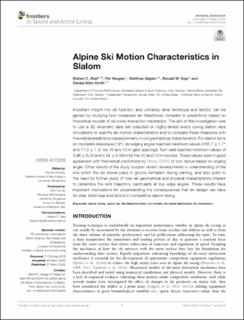| dc.contributor.author | Reid, Robert Cortas | |
| dc.contributor.author | Haugen, Per | |
| dc.contributor.author | Gilgien, Matthias | |
| dc.contributor.author | Kipp, Ronald | |
| dc.contributor.author | Smith, Gerald | |
| dc.date.accessioned | 2021-02-10T07:59:34Z | |
| dc.date.available | 2021-02-10T07:59:34Z | |
| dc.date.created | 2020-11-04T11:29:04Z | |
| dc.date.issued | 2020 | |
| dc.identifier.citation | Frontiers in Sports and Active Living. 2020, 2, Artikkel 25. | en_US |
| dc.identifier.issn | 2624-9367 | |
| dc.identifier.uri | https://hdl.handle.net/11250/2727050 | |
| dc.description | This is an open-access article distributed under the terms of the Creative Commons Attribution License (CC BY). The use, distribution or reproduction in other forums is permitted, provided the original author(s) and the copyright owner(s) are credited and that the original publication in this journal is cited, in accordance with accepted academic practice. No use, distribution or reproduction is permitted which does not comply with these terms. | en_US |
| dc.description.abstract | Important insight into ski function, and ultimately skier technique and tactics, can be gained by studying how measured ski trajectories compare to predictions based on theoretical models of ski-snow interaction mechanics. The aim of this investigation was to use a 3D kinematic data set collected on highly-skilled skiers during slalom race simulations to quantify ski motion characteristics and to compare these measures with theoretical predictions based primarily on ski geometrical characteristics. For slalom turns on moderate steepness (19°), ski edging angles reached maximum values of 65.7 ± 1.7° and 71.0 ± 1.9° for 10 and 13 m gate spacings. Turn radii reached minimum values of 3.96 ± 0.23 and 4.94 ± 0.59 m for the 10 and 13 m courses. These values were in good agreement with theoretical predictions by Howe (2001) of turn radius based on edging angle. Other results of the study support recent developments in understanding of the role which the ski shovel plays in groove formation during carving, and also point to the need for further study of how ski geometrical and physical characteristics interact to determine the ski's trajectory, particularly at low edge angles. These results have important implications for understanding the consequences that ski design can have for skier technique and tactics in competitive slalom skiing. | en_US |
| dc.language.iso | eng | en_US |
| dc.subject | alpine skiing | en_US |
| dc.subject | alpine ski | en_US |
| dc.subject | ski characteristics | en_US |
| dc.subject | ski motion | en_US |
| dc.subject | ski-snow interaction | en_US |
| dc.subject | ski mechanics | en_US |
| dc.title | Alpine Ski Motion Characteristics in Slalom | en_US |
| dc.type | Peer reviewed | en_US |
| dc.type | Journal article | en_US |
| dc.description.version | publishedVersion | en_US |
| dc.rights.holder | © 2020 Reid, Haugen, Gilgien, Kipp and Smith. | en_US |
| dc.source.pagenumber | 11 | en_US |
| dc.source.volume | 2 | en_US |
| dc.source.journal | Frontiers in Sports and Active Living | en_US |
| dc.identifier.doi | 10.3389/fspor.2020.00025 | |
| dc.identifier.cristin | 1844836 | |
| dc.description.localcode | Institutt for fysisk prestasjonsevne / Department of Physical Performance | en_US |
| cristin.ispublished | true | |
| cristin.fulltext | original | |
| cristin.qualitycode | 1 | |
